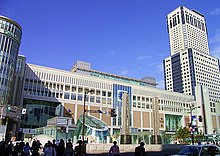|
Hokkaido Railway Company
The Hokkaido Railway Company (北海道旅客鉄道株式会社, Hokkaidō Ryokaku Tetsudō kabushiki gaisha) is one of the constituent companies of the Japan Railways Group (JR Group), and is often referred to using its official abbreviation of JR Hokkaido (JR北海道, Jeiāru Hokkaidō). It operates intercity and local rail services in Hokkaido, Japan. The company introduced Kitaca, a smart card ticketing system, in autumn 2008. At the time of its privatization in 1987, JR Hokkaido operated 21 railway lines totalling 3,176.6 kilometres (1,973.8 mi) of narrow-gauge (1,067 mm (3 ft 6 in)) track, as well as a ferry service to Aomori. Since then, that figure has dwindled to just below 2,500 kilometres (1,600 mi), as unprofitable lines have been shut down or spun off (in the case of the Hokkaidō Chihoku Kōgen Railway). The ferry service has also been replaced by the Seikan Tunnel. On 19 November 2016, JR Hokkaido's president announced plans to further rationalize its network by the withdrawal of services from up to 1,237 km, or about 50% of the current network,[1] including closure of the remaining section of the Rumoi Main Line (the Rumoi - Mashike section closed on 4 December 2016, the Ishikari-Numata to Rumoi section on 31 March 2023 and the Fugagawa to Ishikari-Numata section will close on 31 March 2026), the Shin-Yubari - Yubari section of the Sekisho Line (closed on 1 April 2019), the non-electrified section of the Sassho Line (closed 17 April 2020) and the Nemuro Line between Furano and Shintoku (closed 31 March 2024). Other lines including the Sekihoku Main Line, Senmo Main Line, the Nayoro - Wakkanai section of the Soya Line and Kushiro - Nemuro section of the Nemuro Line are proposed for conversion to Third Sector operation, but if local governments are not agreeable, such sections will also face closure. JR Hokkaido closed 25 stations from March 2021 to March 2022 due to a decrease in passengers.[2][3] JR Hokkaido's headquarters are in Chūō-ku, Sapporo.[4] History
Headquarters and branch offices
Lines and key stations   Shinkansen
Trunk lines
Other lines
Under construction
Former linesThese lines were closed under the ownership of JR Hokkaido since 1987.[5]
The company also operated the Seikan Ferry until 1988. Former JNR lines closed before JR Hokkaido formationThese lines have been closed by JNR in Hokkaido before 1 April 1987.[5]
References
External linksWikimedia Commons has media related to The Hokkaido Railway Company.
|
||||||||||||||||||||||||||||||||




